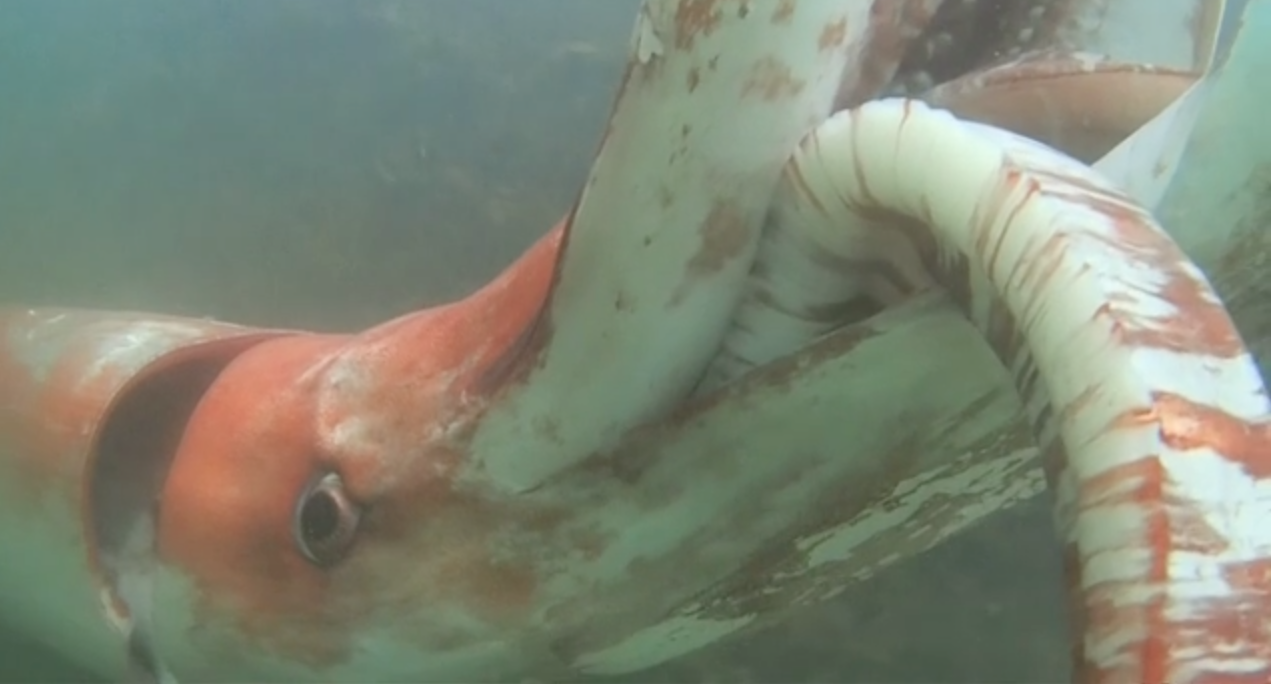
The giant squid has some impressive stats. Measuring up to 18 metres (59ft) in length and weighing up to 900kg, it is the second largest invertebrate known to exist, second only to the even bigger Colossus Squid. Yet despite its huge size, the giant squid has rarely been sighted, with the first images of a live specimen being taken only in 2004. This elusive and fearsome-looking creature therefore became the subject of myths and legends, but today is highly sought after by scientists hoping to learn more about this fascinating creature of the deep.
Since ancient times, tales of the giant squid have been common among those spending their lives at sea. Reports from these seafarers may have given rise to the Norse legend of the kraken. A tentacle sea monster living off the coasts of Norway and Greenland, the kraken was said to be as large as an island and capable of engulfing and sinking any ship. It was taken seriously by the ‘father of taxonomy’ Carolus Linneaus, who gave the kraken the scientific name Microcosmus marinus in the first edition of his Systema Naturae in 1735, although it was subsequently removed from later editions.
The giant squid itself remains prominent in the human imagination, featuring in books such as Moby Dick, Twenty Thousand Leagues Under the Sea, battling James Bond in Dr. No, and dwelling in a lake at Hogwarts school in the Harry Potter series. Scientists have long been fascinated by the giant squid too, and progress has been made to discover more about its life. In 2004, Japanese researchers took the first images ever of a live giant squid and, in 2006, scientists at Japan’s National Science Museum used bait to catch and bring to the surface a live seven metre (24ft) female. In July 2012, a live adult giant squid was filmed for the first time in its natural habitat off Chichi-jima in Japan.
 Prior to these events, giant squid were only known from dead specimens washed up on beaches and caught in fishing nets, or retrieved from the stomachs of dead sperm whales. These whales are believed to be the only predators of adult giant squid, although pilot whales may also feed on them. Juveniles are preyed upon by deep-sea sharks and other fish. Because only single individuals have ever been caught, dead or alive, giant squid are thought to be solitary hunters. Feeding on deep-sea fish and other species of squid, the giant squid catches prey with its two tentacles, using the rows of serrated suckers along the length of them to grip its prey and bring it towards its parrot-like beak.
Prior to these events, giant squid were only known from dead specimens washed up on beaches and caught in fishing nets, or retrieved from the stomachs of dead sperm whales. These whales are believed to be the only predators of adult giant squid, although pilot whales may also feed on them. Juveniles are preyed upon by deep-sea sharks and other fish. Because only single individuals have ever been caught, dead or alive, giant squid are thought to be solitary hunters. Feeding on deep-sea fish and other species of squid, the giant squid catches prey with its two tentacles, using the rows of serrated suckers along the length of them to grip its prey and bring it towards its parrot-like beak.
The tentacles are more than twice the squid’s body length and can shoot out long distances to catch food. It is also helped by its huge, dinner-plate sized eyes—the largest eyes of any animal in the world. Measuring 30cm (1ft) in diameter, they enable the squid to detect small amounts of light, including bioluminescence, in the dark depths of the ocean.
The giant squid is widespread, occurring in all of the world’s oceans. Specimens are rare in tropical and polar latitudes, but are usually found near continental and island slopes in the North Atlantic Ocean, especially Newfoundland, the northern British Isles, Norway, Spain and the oceanic islands of the Azores and Madeira, and also the South Atlantic Ocean around southern Africa. In the Pacific Ocean they have been found around Japan, New Zealand and Australia.
The giant squid travels through the water using its mantle, which contains all its basic organs, and a funnel on the underside. The gentle, rhythmic pulses of water are pushed out of the mantle cavity and through the funnel, which propels the squid forward. It can also move very quickly, by expanding the mantle cavity to fill with water, then contracting its muscles to jet the water out through the funnel.
With a very sophisticated nervous system and complex brain, there is much still to learn from its morphology—knowledge we can gain from dead specimens rising to the surface. Yet if we want to know more about its behaviour and interactions we will have to venture further into its natural habitat, and leave legends behind, in our quest to uncover the secrets of the giant squid.
[geoip-content not_country=”CA”] ON THE APP
Explore the dense kelp forests of the northern Pacific Ocean in the documentary In the Realm of the Giants—Mysterious Cephalopods as you follow expert divers seeking out giant octopi and the legendary Humboldt squid. While studying these intelligent multi-limbed life forms we may discover that they are as curious about us as we are about them. Now streaming on Love Nature. [/geoip-content]
